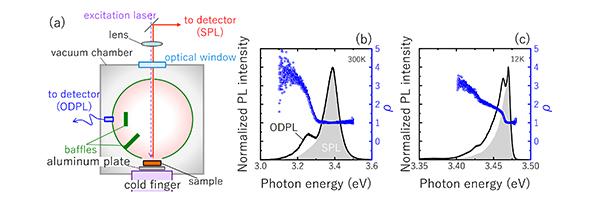New way to measure optical absorption

Tohoku University research fndings confirm the accuracy of omnidirectional photoluminescence (ODP) spectroscopy for probing semiconductor crystals
Tohoku University researchers have revealed more details about omnidirectional photoluminescence (ODPL) spectroscopy - a method for probing semiconducting crystals with light to detect defects and impurities.
"Our findings confirm the accuracy of ODPL measurements and show the possibility to measure optical absorption of crystals by the ODPL method, making the process much easier," says Tohoku University materials scientist Kazunobu Kojima.
Huge strides have been made in the development of efficient electronic and optical devices, e.g. ultraviolet, blue, and white LEDs as well as high-frequency transistors, that use nitride semiconductors - specifically AlGaN, InGaN, and GaN.
GaN is a suitable material for power devices on account of its large bandgap energy, high breakdown field and high saturation electron velocity.
There is a strong need for manufacturers to be able to detect crystal defects and test their efficiency. Within such high quality crystals, the concentration of nonradiative recombination centres (NRC) serves as a good predictor of the crystals quality.
Annihilation spectroscopy, deep-level transient spectroscopy and photoluminescence (PL) spectroscopy are among the estimation techniques for detecting point defects which are the source of NRCs. PL spectroscopy is attractive because it requires no electrodes and contacts.
First proposed by Kojima and his research team in 2016, ODPL is a novel form of PL spectroscopy that measures PL intensity by using an integrating sphere to quantify the quantum efficiency of radiation in sample semiconductor crystals. It is non-touching, non-destructive and good for large-sized GaN wafers for room-lighting LEDs and transistors for electric vehicles. Yet, the origin of the two-peak structure formed in ODPL had remained elusive until now.
Kojima and his team combined ODPL and standard PL (SPL) spectroscopy experiments on a GaN crystal at various temperatures (T) between 12 K and 300 K. The intensity ratio (r) of the ODPL spectra to SPL spectra for the NBE emission of GaN showed a linearly decreasing slope for photon energy (E) below a fundamental absorption edge energy (Eabs).The slope obtained in r corresponded to the so-called Urbach-Martienssen (U-M) absorption tail, which is observed in many semiconductor crystals.
Therefore, the origin of the two-peak structure in the ODPL spectra around the NBE emission of the GaN crystal exists because of the U-M tail.
'Urbach–Martienssen tail as the origin of the two-peak structure in the photoluminescence spectra for the near-band-edge emission of a freestanding GaN crystal observed by omnidirectional photoluminescence spectroscopy' by K. Kojimaa) and S. F. Chichibu; Appl. Phys. Lett. 117, 171103 (2020)


































